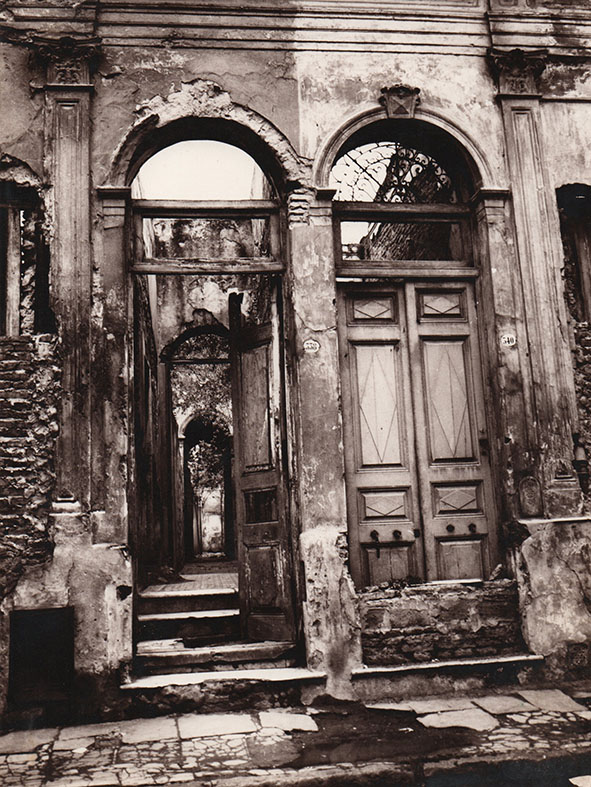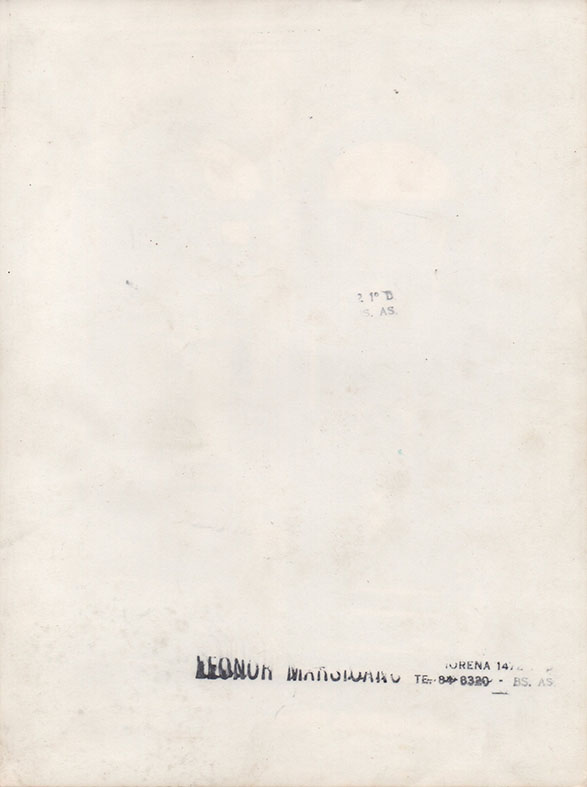Doors of Cochabamba street. San Telmo. Circa 1975.
Vintage gelatin silver print. Measures 23.8 x 17.8 cm / 9.37 x 7 in. On the back the artist's wet stamp: “Leonor Marsicano. Anchorena 1472. T.E. 84.8320 ".
Nostalgic Buenos Aires registry of a pair of twin houses in the San Telmo neighborhood, located at 338 and 340 on Cochabamba Street. The two old fronts are symmetrical. In the worn, chipped walls and the brick-walled windows, you can see the Italianate luxury they used to have. The humidity of the rain of that day accentuated every detail, every wound of these old constructions, as well as the narrow sidewalk with the fragments of its tiles, and on them a pool of water. While the door on the right is closed, the one on the left reveals internal courtyards, with creepers and arcades.
The book Buenos Aires al Sur. Imágenes de San Telmo y más allá... (Buenos Aires. Editorial Gaglianone. 1993) reproduces a photograph with the same entry but taken several years before. Undoubtedly the small changes in her aroused the photographic interest of the author, who again stopped in front of them. In the one we offer, the front of the door on the left had already been detached, and the door on the right has a wall that did not yet exist at the time of the first capture. When we trace those old houses of San Telmo we see that nowadays nothing is preserved. Greater justice than our own words does the fragment of the poem "The crime house" by the poet Raúl González Tuñón, included in his book Poems for the lectern of a pianola and printed on the back of the photograph of the book: "Here was life one time and now no one / travels their enclosures, where the fog dwells. / Closed window, handcuffed door, moon / fainted forever in the mirror”.
LEONOR MARSICANO
Leonor Martínez Baroja (Cenicero, La Rioja, Spain, 1926), with the surname of her mother, was here known as Leonor Marsicano, adopting that of her husband. She emigrated to Buenos Aires at the age of three with her mother and her older sister; but at ten she returned to Spain and returned to Argentina in 1943, at the age of fifteen. Those were difficult times, she worked as a maid, like her mother, although she already wanted to be an artist. Years later, she joined the communist party and there she met her husband. Interested in photography and cinema, a comrade from the party gave her the address of the Russian photographer Anatole Saderman. Leonor became her assistant and Anatole her teacher.
As her teacher, she was a great portraitist. She immortalized among others Sabato, Piazzolla, the painters Carlos Alonso, Carlos Castagnino, Demetrio Urruchúa and Raquel Forner, the sculptor Antonio Pujía and the dancer María Fux. Interested in the political life of her time, she recorded the first appearances of the Mothers of the Plaza de Mayo, and worked for the cultural newspaper Purposses, edited by the writer and playwright Leónidas Barletta.
The other great area of interest of her was the architecture of the city, especially the most neglected. In 1993 she published the book Buenos Aires al Sur. Images of San Telmo and beyond ..., a collection of 27 views of the dizzying 70s, of the “South of Buenos Aires, which is waiting, crouched behind the back of the city. Tango and taciturn south, whose most certain medal has to do with pride and history”. (1) A set of photographs centered on the San Telmo neighborhood, which were exhibited for the last time at the Technology and Humanism Foundation in 1996. The publication was accompanied by poems by Raúl González Tuñón and texts by Camilo Sánchez. She had previously participated in other volumes, such as Forte. The joy of painting (1979) by César Magrini.
At 87 years old, already a widow, she returned to her country to reside in Madrid. Disappointed by the mistreatment received by the Ministry of Culture of Argentina, she is currently looking for an institution that collects and takes responsibility for her legacy, more than forty years of photographs of our country and our people in times when the work of women photographers was not usual, standing out with Grete Stern and Annemarie Heinrich. It was her wish, we read in Spanish articles with interviews that were carried out in 2016 and 2017, that a book of hers be published, and what is collected "serves to investigate the tomb of Lorca, and for the southern neighborhood of Buenos Aires" . (2)
We now present two precious records of her authorship, high quality works with traces of the splendor lost in the Buenos Aires architecture of San Telmo.
Notes:
1. Camilo Sánchez in the preliminary words of the book Buenos Aires al Sur. Imágenes de San Telmo y más allá ...
2. Articles published in Spanish media: El Mundo, by Roberto Bécares (12/11/2016) and in La Rioja.com by Diego Marín (1/17/2017).
| AUTHOR | MARSICANO, LEONOR |
|---|---|
| ITEM | 26 |
Are you interested in selling some works?
Send us an email briefly indicating
which works you intend to put on sale, and we will respond. click here
Subscribe to our newsletter to be updated.
Check our Newsletters
